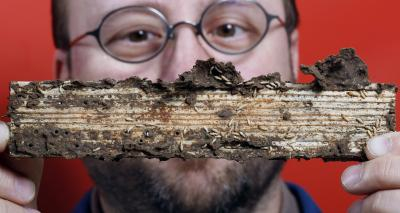The digestive apparatus of the term acts as a biofuel refinery
Termites are one of the insects that nibble on any wooden item in households, the presence of termites is considered a disaster for households. However, scientists have been able to prove that research on termite digestion is really helpful.
Mike Scharf, chairman of the Urban Insight Research Laboratory and O. Wayne Rollins / Orkin, said his lab discovered a mixture of intestinal enzymes of the termite. Effective in removing wood barriers, inhibiting the release of two sugars from biomass . Scharf found that the enzymes in termite play a major role, effectively assisting in the digestion of the amount of wood eaten. The discovery was published online in PLoS One , this is the first time scientists have measured the yield of sugar produced by enzymes in termite gut and from symbiotic organisms and small organisms. Raw living in termite gut and supporting wood digestion in termite gut.

Wood is one of the biggest barriers to ejection
Like the types of sugars in biomass
" Previously, researchers did not pay much attention to the source of enzymes present in the termite gut, because they could not expect that these enzymes could be used in the production of biofuels. For a long time people thinking, only the gut symbionts are responsible for wood digestion , "Scharf added. " Certainly symbiotic organisms have made a significant contribution, but what we see is the term that creates synergistic enzymes in wood digestion with enzymes created by symbiotic organisms. In the termite intestine, this combination has the effect of strengthening the enzyme's functional activity by 4 times . "
Scharf and his partner conducted separate studies on termite gut, testing the termite gut containing and not containing symbiotic organisms on sawdust to measure the amount of sugar produced.
Once the enzymes were identified, Scharf and his team worked with Chesapeake Perl, a protein manufacturing company in Maryland, USA, to create a synthetic version. The genes responsible for the creation of termite enzymes are introduced into a virus and fed to caterpillars, after which large amounts of enzymes are produced in the caterpillar gut. Tests showed that synthetic versions of host-term enzymes were also effective in releasing sugar from biomass .

Researchers have discovered three functional synthetic enzymes on different parts of biomass.
Two enzymes are responsible for glucose and pentose release, two different sugars. While the remaining enzyme decomposes wood, rigid compounds help form plant cells.
Wood is one of the biggest barriers preventing the release of sugars in biomass. Scharf said that enzymes derived from termites and termite symbiotic organisms, as well as synthetic versions, could be effective in removing wood barriers.
The amount of sugar extracted from plant material is necessary to create biofuels. This sugar is fermented to produce products like ethanol.
" We found a mixture of enzymes that make wood sugars ," Scharf said. " We can also see for the first time that termite hosts and symbiotic organisms can support each other to create two different types of sugars ."
Next step, Scharf said, his team will embark on determining how symbiotic organisms' enzymes can be combined with termite enzymes to release maximum amounts of sugar from wood. resources. Combining these enzymes together will increase the amount of biofuels available from biomass.
The US Department of Energy and Chesapeake Perl Company funded this study.
- The Israeli group considered building a seawater refinery in Vietnam
- Long-term gastrointestinal disorders in the weak abdomen
- Overview of biofuels
- The boy suffered a fracture due to digestive disorders
- New equipment turns breath into biofuel
- Disaster response for Dung Quat oil refinery
- 9 mysterious powers of the human body
- Converting waste cooking oil into biofuel
- Superfuel transport trial biofuel
- 8 habits that help the digestive system stay healthy
- Smart pill helps to study the gas composition in the patient's digestive system
- The first seawater refinery in Central Vietnam
 Why do potatoes have eyes?
Why do potatoes have eyes? 'Tragedy' the world's largest carnivorous life: Death becomes ... public toilet
'Tragedy' the world's largest carnivorous life: Death becomes ... public toilet Tomatoes were once considered 'poisonous' for 200 years
Tomatoes were once considered 'poisonous' for 200 years Detecting microscopic parasites on human face
Detecting microscopic parasites on human face